Antarctica is undoubtedly a subject that is passionate, but it’s also a reality object of investments, of energies spent on studies and researches that for years are involving the whole world.
 For those who did not know, in 1975 the first Italian adventure in Antarctica did start by a private expedition carried out by a Milanese entrepreneur: Renato Cepparo.
For those who did not know, in 1975 the first Italian adventure in Antarctica did start by a private expedition carried out by a Milanese entrepreneur: Renato Cepparo.
Italy did sign the Antarctic Treaty in 1981, a good 6 years after Cepparo’s expedition that built a scientific base in a place called Ezcurra Inlet in front of Admiralty Bay, South Shetland Islands in Antarctica.
The literature is full of stories of Renato Cepparo (I1SR) who named his Base (picture aside) after the Italian explorer Giacomo Bove (WAP ITA-Ø2) and the fact that Italian government, fully disinterested in this tricolor flagging outpost, in 1976 gave it to Argentina which dismantled it by plundering the equipments that Cepparo had left in the Base Bove laboratory. Currently in that place, only the foundation on which the building was based is still visible. Poland, who have his research site (Arctowski Station) nearby, did call Italia Valley the place where the first Italian Base in Antarctica was built.
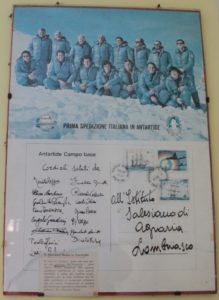 Now, going out the gymnasium of the Salesian Institute of Lombriasco (Turin, Italy) I did find, hanging on a wall, a postcard signed by the members of the Cepparo expedition, sent on December 25, 1975 from Antarctica to the Salesian Institute of Agriculture of Lombriasco; besides being a precious rarity, it’s a real scoop!
Now, going out the gymnasium of the Salesian Institute of Lombriasco (Turin, Italy) I did find, hanging on a wall, a postcard signed by the members of the Cepparo expedition, sent on December 25, 1975 from Antarctica to the Salesian Institute of Agriculture of Lombriasco; besides being a precious rarity, it’s a real scoop!
Don Marco Casanova, Director of the Salesian School complex says: – Since my arrival in Lombriasco, I have always seen it there and sincerely, I have never deepened the link between the Salesians, Antarctica and the expedition of Renato Cepparo-.
But there is a bit more: within the frame, a typescript was inserted in; it says: – St. John Bosco in Antarctica – On the subject, perhaps not everyone knows that Patron of the Antarctica – where last year seemed even to break the third world war because of the Anglo-Argentine conflict in the Falklands Islands, gave rise to numerous collections that are now appearing in more and more philatelic exhibitions – is the Salesian St. John Bosco .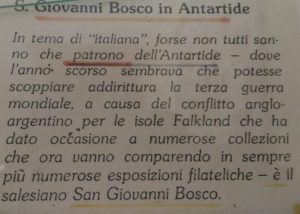
Therefore, the Italian Cepparo expedition in Antarctica took place in “December 1975-January 1976“, the Falklands war mentioned in the brief paragraph dates June 1982.
It is likely that the typescript has been inserted inside the frame after 1982 and the question that arises now is: Is the Salesian St. John Bosco truly the Protector of Antarctica? It would be great, even if researches have been carried out, this news is not confirmed yet.
 Officially opened on 20 March 1968; the US Palmer Research Station (WAP USA-23) on Anvers Island focuses primarily on Antarctic marine biology and zoology.
Officially opened on 20 March 1968; the US Palmer Research Station (WAP USA-23) on Anvers Island focuses primarily on Antarctic marine biology and zoology.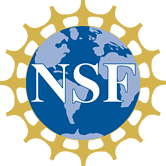 States Antarctic stations, as well as Arthur Harbour and the Bismarck Strait beyond. Palmer station webcam at: https://www.usap.gov/videoclipsandmaps/palwebcam.cfm
States Antarctic stations, as well as Arthur Harbour and the Bismarck Strait beyond. Palmer station webcam at: https://www.usap.gov/videoclipsandmaps/palwebcam.cfm
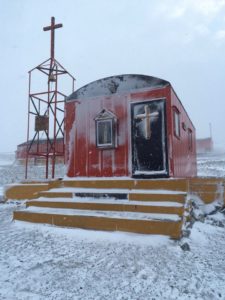 Christianity was first established in Antarctica by Captain Aeneas Mackintosh who erected a cross on Wind Vane Hill in 1916. The first religious service was conducted in Antarctica in 1947 by William Menster with about 2,000 people from different Christian denominations in attendance. Research and whaling stations were erected in the large area of Antarctica in the early 1900s. Since then, several scientists are attending the area especially during summer while a few people stay over during winter. The extended stay in the region can be stressful and challenging for researchers. The Jesuit geophysicists have contributed to the growth of religion in the continent through Antarctica mission work. The religion in Antarctica dates back to the discovery of the continent in 18th century. However, Christianity was the first religious practice in the continent.
Christianity was first established in Antarctica by Captain Aeneas Mackintosh who erected a cross on Wind Vane Hill in 1916. The first religious service was conducted in Antarctica in 1947 by William Menster with about 2,000 people from different Christian denominations in attendance. Research and whaling stations were erected in the large area of Antarctica in the early 1900s. Since then, several scientists are attending the area especially during summer while a few people stay over during winter. The extended stay in the region can be stressful and challenging for researchers. The Jesuit geophysicists have contributed to the growth of religion in the continent through Antarctica mission work. The religion in Antarctica dates back to the discovery of the continent in 18th century. However, Christianity was the first religious practice in the continent.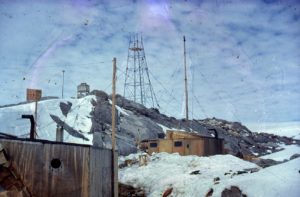
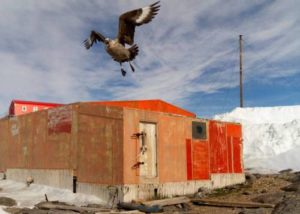
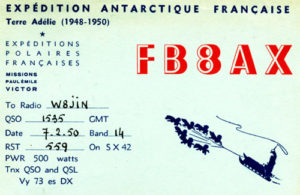 entirely available online. It is an excellent testimony of the daily life conditions in Antarctica in 1950s in which clearly appear FB8AX (René Gros from 7mns10s to 8mns 00s then Mario Marret from 9mns53 to 57s).
entirely available online. It is an excellent testimony of the daily life conditions in Antarctica in 1950s in which clearly appear FB8AX (René Gros from 7mns10s to 8mns 00s then Mario Marret from 9mns53 to 57s).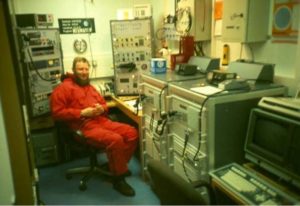 Volker Strecke DL8JDX is a great friend and an Antarctic veteran who did participate to several Antarctic Expeditions from 1988 through 1994.
Volker Strecke DL8JDX is a great friend and an Antarctic veteran who did participate to several Antarctic Expeditions from 1988 through 1994.
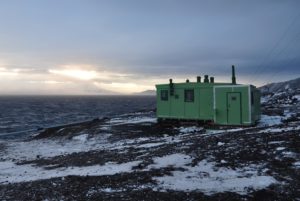 Nestled alongside Scott Base (WAP NZL-Ø1) in Antarctica, is Hillary’s Hut, a small building that’s played a big role in New Zealand’s history. Hillary’s Hut was the first building constructed at Scott Base. It was built by a team led by Sir Edmund Hillary in 1957 and it was from here that Sir Ed later led the historic expedition to the South Pole.
Nestled alongside Scott Base (WAP NZL-Ø1) in Antarctica, is Hillary’s Hut, a small building that’s played a big role in New Zealand’s history. Hillary’s Hut was the first building constructed at Scott Base. It was built by a team led by Sir Edmund Hillary in 1957 and it was from here that Sir Ed later led the historic expedition to the South Pole.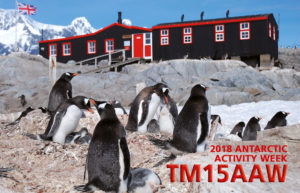 Thanks to F8DVD, always present since the 1st edition of the Antarctic Activity Week, 15 years ago!
Thanks to F8DVD, always present since the 1st edition of the Antarctic Activity Week, 15 years ago!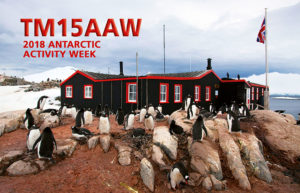 Port Lockroy is situated on Goudier Island in the Palmer Archipelago (64°49’S – 63° 30’W) about 700 miles south of Argentina and Chile. The bay was discovered during Jean-Baptiste Charcot’s French Antarctic expedition in 1904 and was named after Edouard Lockroy, a French politician and Vice President of the Chamber of Deputies, who assisted the explorer in obtaining government funding for his expedition.
Port Lockroy is situated on Goudier Island in the Palmer Archipelago (64°49’S – 63° 30’W) about 700 miles south of Argentina and Chile. The bay was discovered during Jean-Baptiste Charcot’s French Antarctic expedition in 1904 and was named after Edouard Lockroy, a French politician and Vice President of the Chamber of Deputies, who assisted the explorer in obtaining government funding for his expedition.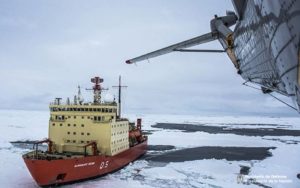 The Argentine Ministry of Defense reports, by the Antarctic joint commander, Marine Commodore Pablo Fal that the crew of the Icebreaker Almirante Irízar rescued five US scientists who were stranded in Antarctica.
The Argentine Ministry of Defense reports, by the Antarctic joint commander, Marine Commodore Pablo Fal that the crew of the Icebreaker Almirante Irízar rescued five US scientists who were stranded in Antarctica.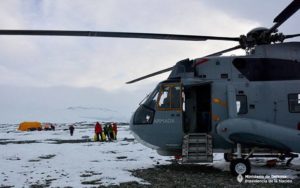 request of the Argentine Foreign Ministry and went to Joinville Island to rescue the scientists.
request of the Argentine Foreign Ministry and went to Joinville Island to rescue the scientists.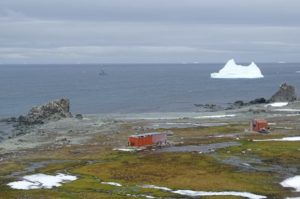 Francisco de Gurruchaga Antarctic Naval Refuge (62°14’03.0″ South, 59°10’02.0″ West), also known as Armonia Refuge or Harmony Haven has been recently referenced with WAP ARG-28 following the activity of Juan Manuel Pereda who did operate from there as LU4CJM/Z from Jan. 8th through 22nd 2017.
Francisco de Gurruchaga Antarctic Naval Refuge (62°14’03.0″ South, 59°10’02.0″ West), also known as Armonia Refuge or Harmony Haven has been recently referenced with WAP ARG-28 following the activity of Juan Manuel Pereda who did operate from there as LU4CJM/Z from Jan. 8th through 22nd 2017.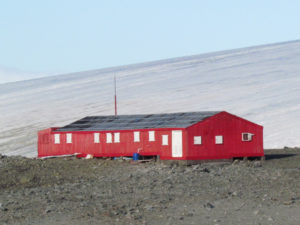 On the hill about 500m from Esperanza is Trinity House, a hut remaining from “Base D”, built by the UK in 1944–45 and closed in 1963. It was transferred to Uruguay in 1997 and is now named Ruperto Elichiribehety Station after the captain of Uruguayan steam trawler Instituto de Pesca No 1, which Shackleton used in his second of three unsuccessful attempts to reach the Elephant Island castaways. The summer-only facility accommodates eight.
On the hill about 500m from Esperanza is Trinity House, a hut remaining from “Base D”, built by the UK in 1944–45 and closed in 1963. It was transferred to Uruguay in 1997 and is now named Ruperto Elichiribehety Station after the captain of Uruguayan steam trawler Instituto de Pesca No 1, which Shackleton used in his second of three unsuccessful attempts to reach the Elephant Island castaways. The summer-only facility accommodates eight.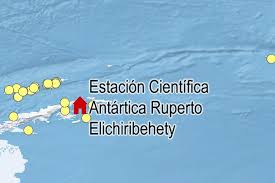
 The commander of a Spanish Navy Rsearch Ship has died in Antarctica after apparently falling overboard.
The commander of a Spanish Navy Rsearch Ship has died in Antarctica after apparently falling overboard.
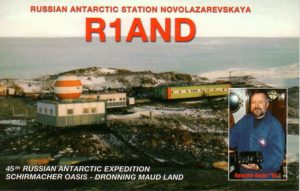 Oleg Sakharov UA1PBA/ZS1ANF/RI1ANF was helpful to understand a bit more, so thanks to him, now the story is more clear.
Oleg Sakharov UA1PBA/ZS1ANF/RI1ANF was helpful to understand a bit more, so thanks to him, now the story is more clear.
 Viktor, the ship’s Communications Officer and Ivan, the ship’s electrician. Their assistance was crucial to what success I was to enjoy.
Viktor, the ship’s Communications Officer and Ivan, the ship’s electrician. Their assistance was crucial to what success I was to enjoy. The next day, Viktor and Ivan assisted me in pulling the tuner and inspecting it. The concern of the Captain was such that we had to provide him with complete assurance that he would not be aware that I was operating the radio. The decision was made to forgo the amplifier and instead try to use it’s built in tuner to produce a matched input to the Pacific Aerials 7.3 meter vertical. A match could not be achieved. I used the ship’s commercial internet service to notify the group of my predicament and then relegated myself to being a tourist only.
The next day, Viktor and Ivan assisted me in pulling the tuner and inspecting it. The concern of the Captain was such that we had to provide him with complete assurance that he would not be aware that I was operating the radio. The decision was made to forgo the amplifier and instead try to use it’s built in tuner to produce a matched input to the Pacific Aerials 7.3 meter vertical. A match could not be achieved. I used the ship’s commercial internet service to notify the group of my predicament and then relegated myself to being a tourist only.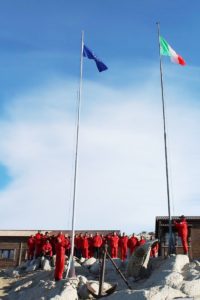 With more than fifty scientific projects done, with the lowering flag’s ceremony the activities of the XXXIII Summer 2017-2018 Campaign of the Italian National Program of Research in Antarctica (PNRA) at Mario Zucchelli Station (WAP ITA-Ø1) of Terra Nova Bay, are finished.
With more than fifty scientific projects done, with the lowering flag’s ceremony the activities of the XXXIII Summer 2017-2018 Campaign of the Italian National Program of Research in Antarctica (PNRA) at Mario Zucchelli Station (WAP ITA-Ø1) of Terra Nova Bay, are finished. research and logistics activities within the Antarctic Continent; 25 specialists of the 3 Armed Forces have been involved: mountain scouts, pilots, weather forecasters, mechanics, riders and divers gave a great contribution to the success of the Summer campaign.
research and logistics activities within the Antarctic Continent; 25 specialists of the 3 Armed Forces have been involved: mountain scouts, pilots, weather forecasters, mechanics, riders and divers gave a great contribution to the success of the Summer campaign.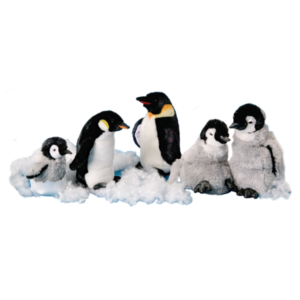 Tourist numbers on the Icy Continent have grown by twenty times in 30 years. Tourism in Antarctica has risen from fewer than 2,000 visitors in the 1980s to more than 45,000 visitors from around the world last year. The number of people travelling to the frozen continent dipped during the economic recession of the late 2000s, but rose again in recent years, according to data kept by the Rhode-Island based International Association of Antarctic Tour Operators.
Tourist numbers on the Icy Continent have grown by twenty times in 30 years. Tourism in Antarctica has risen from fewer than 2,000 visitors in the 1980s to more than 45,000 visitors from around the world last year. The number of people travelling to the frozen continent dipped during the economic recession of the late 2000s, but rose again in recent years, according to data kept by the Rhode-Island based International Association of Antarctic Tour Operators.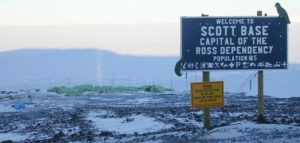 As the base was named after British explorer Robert Falcon Scott, the New Zealand flag was raised on a flagstaff that had been used by Scott at Hut Point in 1903. Originally established to support the privately run Commonwealth Trans-Antarctic Expedition of 1955-58, it was to accommodate both the New Zealand party and a party of New Zealand scientists attached to the expedition who also contributed to the International Geophysical Year. These parties were the first to spend winter over at Scott Base. At the Completion of the expedition, Scott Base became the property of the New Zealand Government in agreement with the Ross Sea Committee. Source:
As the base was named after British explorer Robert Falcon Scott, the New Zealand flag was raised on a flagstaff that had been used by Scott at Hut Point in 1903. Originally established to support the privately run Commonwealth Trans-Antarctic Expedition of 1955-58, it was to accommodate both the New Zealand party and a party of New Zealand scientists attached to the expedition who also contributed to the International Geophysical Year. These parties were the first to spend winter over at Scott Base. At the Completion of the expedition, Scott Base became the property of the New Zealand Government in agreement with the Ross Sea Committee. Source:  II3BOVE is one of the Special Callsign to be aired, along with several others, within the initiatives of the 15th Antarctic Week 2018 scheduled from 17 to 25 February. In particular II3BOVE (WAP-271) aims to remember the first Italian Scientific Base in Antarctica, set in January 1976 by Cav. Renato Cepparo (I2VZP) and named after Giacomo Bove, the Italian explorer who at the end of 1800 sailed to the South to arrange an expedition on the Antarctic Continent. The Base, was active until 20th February 1976 as I1SR/MM.
II3BOVE is one of the Special Callsign to be aired, along with several others, within the initiatives of the 15th Antarctic Week 2018 scheduled from 17 to 25 February. In particular II3BOVE (WAP-271) aims to remember the first Italian Scientific Base in Antarctica, set in January 1976 by Cav. Renato Cepparo (I2VZP) and named after Giacomo Bove, the Italian explorer who at the end of 1800 sailed to the South to arrange an expedition on the Antarctic Continent. The Base, was active until 20th February 1976 as I1SR/MM. only eight months after its construction and now only a stone path remains to remember its foundations. II3BOVE wish to recall the facts and remember the memory.
only eight months after its construction and now only a stone path remains to remember its foundations. II3BOVE wish to recall the facts and remember the memory.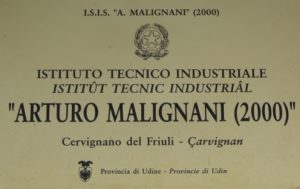 activity promotes with scientific research.
activity promotes with scientific research.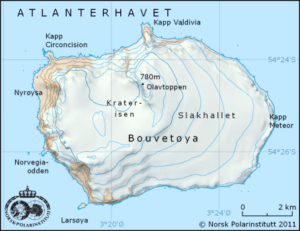 Cape Circoncision (Norwegian: Kapp Circoncision) (54° 23′ 48″ South, 3° 17′ 30″ East) is a peninsula on the north-western edge of subantarctic Bouvet Island.
Cape Circoncision (Norwegian: Kapp Circoncision) (54° 23′ 48″ South, 3° 17′ 30″ East) is a peninsula on the north-western edge of subantarctic Bouvet Island.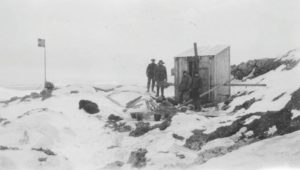
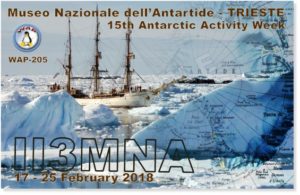 Special callsign II3MNA WAP-205 is on the air during the15th Antarctic Week 2018 operating from MNA – “Museo Nazionale dell’Antartide” in Trieste, Italy. QSL via IQ3TS
Special callsign II3MNA WAP-205 is on the air during the15th Antarctic Week 2018 operating from MNA – “Museo Nazionale dell’Antartide” in Trieste, Italy. QSL via IQ3TS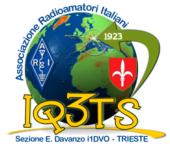 Trieste exposition is organized in a surface of 600 sq. meters, where valuable collections, attractive sceneries and multimedia products, underline current scientific subjects, like climate change, anthropic impact on the environment, biodiversity and space research. This Museum is divided in three sectors: the first one is devoted to Antarctic historical cartography, including valuable ancient maps; the second sector is dedicated to the conquest and exploration of the Antarctic continent, highlighting the three pioneers, protagonists of the most difficult adventures of the world: Scott, Shackleton and Amundsen; the third and last sector is focused exclusively on the Italian expeditions from the 900’s until nowadays organized and realized by “Progetto Nazionale delle Ricerche in Antartide” (PNRA).
Trieste exposition is organized in a surface of 600 sq. meters, where valuable collections, attractive sceneries and multimedia products, underline current scientific subjects, like climate change, anthropic impact on the environment, biodiversity and space research. This Museum is divided in three sectors: the first one is devoted to Antarctic historical cartography, including valuable ancient maps; the second sector is dedicated to the conquest and exploration of the Antarctic continent, highlighting the three pioneers, protagonists of the most difficult adventures of the world: Scott, Shackleton and Amundsen; the third and last sector is focused exclusively on the Italian expeditions from the 900’s until nowadays organized and realized by “Progetto Nazionale delle Ricerche in Antartide” (PNRA).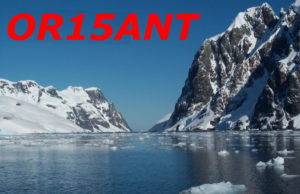 Jean Pierre Hubert ON7ZM, was in Antarctica in Feb 2009 with F5PFP; a great expedition still on the memory of many DXers and Antarctic hunters. Together they did activate several remote sites and Research Bases, some of them very rare!
Jean Pierre Hubert ON7ZM, was in Antarctica in Feb 2009 with F5PFP; a great expedition still on the memory of many DXers and Antarctic hunters. Together they did activate several remote sites and Research Bases, some of them very rare!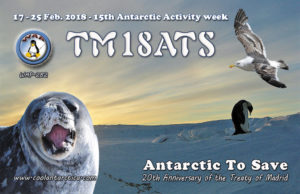 Two more days then the 15th AAW will officially start.
Two more days then the 15th AAW will officially start. Russian President Vladimir Putin was awarded a prize by the Russian Geographical Society in the category “Popularization of natural, historical and cultural heritage of Russia”.
Russian President Vladimir Putin was awarded a prize by the Russian Geographical Society in the category “Popularization of natural, historical and cultural heritage of Russia”.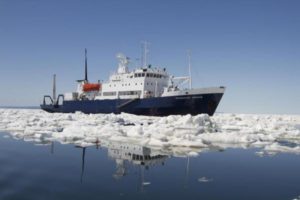 From a message sent (right now) by High Seas Satellite Phone, John Landrigan (K4RXP) said that KA4RXP/MM WILL NOT be operational from February 9 to March 8, 2018 due to failure of two relays in auto tune unit.
From a message sent (right now) by High Seas Satellite Phone, John Landrigan (K4RXP) said that KA4RXP/MM WILL NOT be operational from February 9 to March 8, 2018 due to failure of two relays in auto tune unit.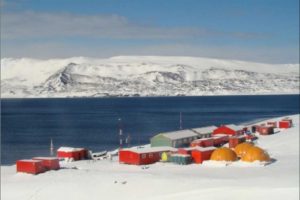 Gabriel de Castilla is actually a Spanish Research Station located on Deception island in the South Shetlands Group, but it was first a military shelter (called Gabriel de Castilla Refuge), when it was constructed during the 1989/90 campaign. (see thetwo pics here below on the right)
Gabriel de Castilla is actually a Spanish Research Station located on Deception island in the South Shetlands Group, but it was first a military shelter (called Gabriel de Castilla Refuge), when it was constructed during the 1989/90 campaign. (see thetwo pics here below on the right)
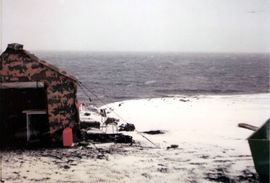 expeditions; six Spanish Army officials took part in the first campaign (1987-88).
expeditions; six Spanish Army officials took part in the first campaign (1987-88).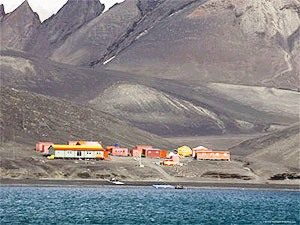 Polar projects are usually funded by the National Plan for Research, Development and Innovation after a peer-review process of proposals.
Polar projects are usually funded by the National Plan for Research, Development and Innovation after a peer-review process of proposals.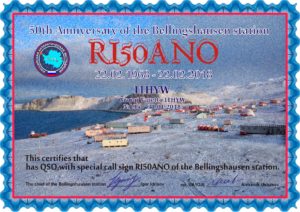 Don’t forget to contact Alexandr A. Ushakov, UA1OJL, who is actually operating from Bellingshausen Station as RI5ØANO to celebrate the 50th Anniversary of its foundation.
Don’t forget to contact Alexandr A. Ushakov, UA1OJL, who is actually operating from Bellingshausen Station as RI5ØANO to celebrate the 50th Anniversary of its foundation. Expedition vessel M/V Ivan Papanin, after completing cargo operations at Bharati Station (WAP IND-Ø4) Larsemann Hills (69° 24’ 24.4” South, 76° 11’ 42.9” East) started her onward journey at 23:35 Hrs local time (18:35 UTC) on Monday, 05 February 2018 heading to the second Indian Station Matiri (WAP IND-Ø3) at Schirmacher Oasis (70° 46’ 00” South, 11° 43’ 50.8” East).
Expedition vessel M/V Ivan Papanin, after completing cargo operations at Bharati Station (WAP IND-Ø4) Larsemann Hills (69° 24’ 24.4” South, 76° 11’ 42.9” East) started her onward journey at 23:35 Hrs local time (18:35 UTC) on Monday, 05 February 2018 heading to the second Indian Station Matiri (WAP IND-Ø3) at Schirmacher Oasis (70° 46’ 00” South, 11° 43’ 50.8” East).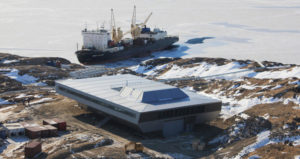 station (see stock pic aside)
station (see stock pic aside) For those who did not know, in 1975 the first Italian adventure in Antarctica did start by a private expedition carried out by a Milanese entrepreneur: Renato Cepparo.
For those who did not know, in 1975 the first Italian adventure in Antarctica did start by a private expedition carried out by a Milanese entrepreneur: Renato Cepparo. Now, going out the gymnasium of the Salesian Institute of Lombriasco (Turin, Italy) I did find, hanging on a wall, a postcard signed by the members of the Cepparo expedition, sent on December 25, 1975 from Antarctica to the Salesian Institute of Agriculture of Lombriasco; besides being a precious rarity, it’s a real scoop!
Now, going out the gymnasium of the Salesian Institute of Lombriasco (Turin, Italy) I did find, hanging on a wall, a postcard signed by the members of the Cepparo expedition, sent on December 25, 1975 from Antarctica to the Salesian Institute of Agriculture of Lombriasco; besides being a precious rarity, it’s a real scoop!
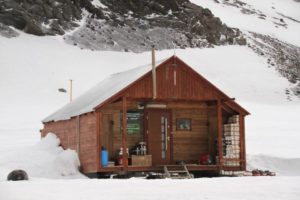 Lions Rump Refuge (62° 06′ South, 58° 05′ West) is a strip of ice-free beaches, moraines and rocks, located on the King George Bay. It is separated from Arctowski Station (WAP POL-Ø1) by a glacier and the waters of the Bransfield Strait. The majority of this area is protected as ASPA 151 (Antarctic Special Protected Area), which in general can be called the equivalent of our nature reserve. The name of the refuge comes from the rock,Lions Rump rlocated in the ASPA.
Lions Rump Refuge (62° 06′ South, 58° 05′ West) is a strip of ice-free beaches, moraines and rocks, located on the King George Bay. It is separated from Arctowski Station (WAP POL-Ø1) by a glacier and the waters of the Bransfield Strait. The majority of this area is protected as ASPA 151 (Antarctic Special Protected Area), which in general can be called the equivalent of our nature reserve. The name of the refuge comes from the rock,Lions Rump rlocated in the ASPA.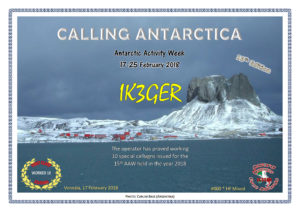 All WAP (Worldwide Antarctic Program) stations have a special WAP reference number that will be given during the QSO.
All WAP (Worldwide Antarctic Program) stations have a special WAP reference number that will be given during the QSO. It’s now time to book the 15th AAW, getting your special call, your WAP reference number and jump into the unique International Ham event to promote Antarctica … join in and enjoy it!
It’s now time to book the 15th AAW, getting your special call, your WAP reference number and jump into the unique International Ham event to promote Antarctica … join in and enjoy it! February 25nd. Someone may ask the reason of why this edition is two days longer than the past years; well, several participants did ask the possibility to have 2 weekends instead of 1 … so this year will be a test, if 2 more days are felt too long, next edition will return back to 7 days activity.
February 25nd. Someone may ask the reason of why this edition is two days longer than the past years; well, several participants did ask the possibility to have 2 weekends instead of 1 … so this year will be a test, if 2 more days are felt too long, next edition will return back to 7 days activity.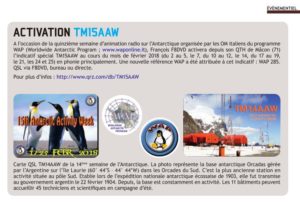 the January issue of REF bulletin.
the January issue of REF bulletin. Pedro LU1JHF, informs WAP that Juan C. Benavente (LU8DBS) is actually active from Base T.te Benjamin Matienzo 64° 58’ 34” South, 60° 04’ 05” West, as LU1ZAB. Check daily on 7,118 MHz. from 23:00 (UTC) and sometimes from 02: 00 (UTC), in SSB. Juan should be there till February 2018
Pedro LU1JHF, informs WAP that Juan C. Benavente (LU8DBS) is actually active from Base T.te Benjamin Matienzo 64° 58’ 34” South, 60° 04’ 05” West, as LU1ZAB. Check daily on 7,118 MHz. from 23:00 (UTC) and sometimes from 02: 00 (UTC), in SSB. Juan should be there till February 2018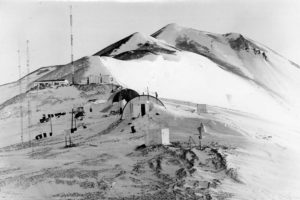
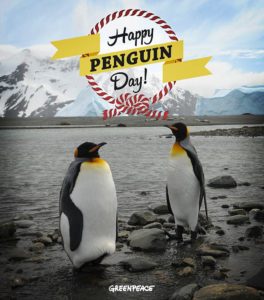 20 January is a day dedicated to the world of penguins: did you know that they are aquatic animals and that their survival depends on the health of the oceans? Protecting their ecosystem is the only way to help them.
20 January is a day dedicated to the world of penguins: did you know that they are aquatic animals and that their survival depends on the health of the oceans? Protecting their ecosystem is the only way to help them.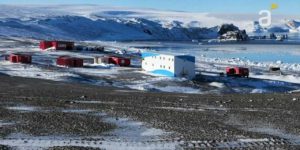 with about 5 tons of frozen food and 226,000 liters of Antarctic gas oil.
with about 5 tons of frozen food and 226,000 liters of Antarctic gas oil. Russian Antarctic Bases Award (RABA) managed by Russian Robinson Club is given for QSO/SWL with radio stations situated on the territory of the ex USSR and Russian Antarctic Bases. Certificates are issued in three different classes with Plaque – Honour Roll and the last born “Plaque.of Excellence”.
Russian Antarctic Bases Award (RABA) managed by Russian Robinson Club is given for QSO/SWL with radio stations situated on the territory of the ex USSR and Russian Antarctic Bases. Certificates are issued in three different classes with Plaque – Honour Roll and the last born “Plaque.of Excellence”. The station will be set on Inexpressible Island in Terra Nova Bay in the Ross Sea. After it is built, the year-round base will be used to investigate the land, sea, atmosphere, and glaciers in the Antarctic. Chinese icebreaker ‘Xuelong is bound for Antarctica with construction materials in tow to build the country’s fifth scientific research station on the continent.
The station will be set on Inexpressible Island in Terra Nova Bay in the Ross Sea. After it is built, the year-round base will be used to investigate the land, sea, atmosphere, and glaciers in the Antarctic. Chinese icebreaker ‘Xuelong is bound for Antarctica with construction materials in tow to build the country’s fifth scientific research station on the continent. Despite its frigid solitude, at several sites in the Antarctic nations from around the world have joined forces in the name of research: the Argentinian Carlini Station ( ex- Estacion Cientifica T.te Jubany) WAP ARG-20 on King George Island, one of the South Shetland Islands, is a prime example:Different nations, all under one roof,
Despite its frigid solitude, at several sites in the Antarctic nations from around the world have joined forces in the name of research: the Argentinian Carlini Station ( ex- Estacion Cientifica T.te Jubany) WAP ARG-20 on King George Island, one of the South Shetland Islands, is a prime example:Different nations, all under one roof,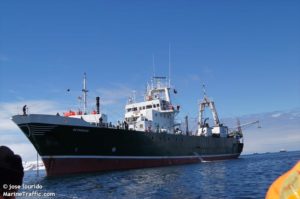 DAP, the Chilean company that owns and operates the M/V Betanzos and the helicopters with a cost of almost 1/2 million U.S. dollars.
DAP, the Chilean company that owns and operates the M/V Betanzos and the helicopters with a cost of almost 1/2 million U.S. dollars.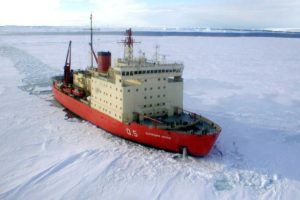 The Argentinean Antarctic Summer Campaign 2017/2018, formally started on last December 18, 2017, when the ship “Estrecho de San Carlos” and the naval transport “Canal de Beagle” sailed from the port of Buenos Aires.
The Argentinean Antarctic Summer Campaign 2017/2018, formally started on last December 18, 2017, when the ship “Estrecho de San Carlos” and the naval transport “Canal de Beagle” sailed from the port of Buenos Aires. Kerry Peters was an elementary school teacher when he was offered retirement . He didn’t really had any of those “What will I do with myself now?” anxieties. He took retirement when it was offered, because he was already looking forward to what came next: exploring the polar regions.
Kerry Peters was an elementary school teacher when he was offered retirement . He didn’t really had any of those “What will I do with myself now?” anxieties. He took retirement when it was offered, because he was already looking forward to what came next: exploring the polar regions.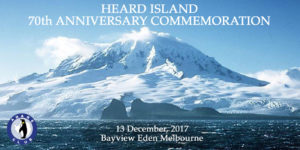 Lee Moyle VK3GK is operating VI7ØHI, a Special Callsign issued to Commemorate the first ANARE Expedition to Heard Island in December 1947.
Lee Moyle VK3GK is operating VI7ØHI, a Special Callsign issued to Commemorate the first ANARE Expedition to Heard Island in December 1947. dog run, and a large tractor. These men carried out meteorological, geophysical, upper atmosphere, and biological research, a program that continued for 7 years until the base was abandoned. Since 1969, ANARE has visited Heard Island every few years, mostly to check up on the ruins of the original encampment.
dog run, and a large tractor. These men carried out meteorological, geophysical, upper atmosphere, and biological research, a program that continued for 7 years until the base was abandoned. Since 1969, ANARE has visited Heard Island every few years, mostly to check up on the ruins of the original encampment.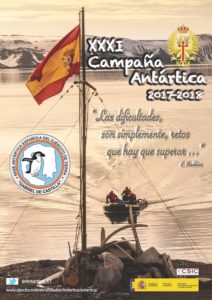 230 people will participate to the XXXI Spanish Antarctic Campaign, carry out 16 research projects, two of them aboard the Hespérides Oceanographic Research Ship, which will also support five international projects of Germany , Belgium, Colombia and Portugal. In addition, in this campaign will also be released a warehouse module at the Gabriel de Castilla Antarctic Base, (WAP ESP-Ø2) managed by the Spanish Army.
230 people will participate to the XXXI Spanish Antarctic Campaign, carry out 16 research projects, two of them aboard the Hespérides Oceanographic Research Ship, which will also support five international projects of Germany , Belgium, Colombia and Portugal. In addition, in this campaign will also be released a warehouse module at the Gabriel de Castilla Antarctic Base, (WAP ESP-Ø2) managed by the Spanish Army.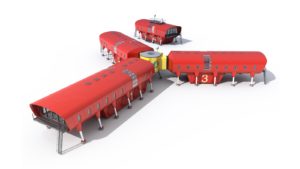
 The new buildings, set in the shape of a clover or tripod, has 2,000 square meters of living space, 600 meters of laboratories, 1,500 square meters of storage, and capacity for 52 people per module.
The new buildings, set in the shape of a clover or tripod, has 2,000 square meters of living space, 600 meters of laboratories, 1,500 square meters of storage, and capacity for 52 people per module. To the thousands of Antarctic friends & followers, to the Teams working actually in Antarctic Stations and remote camps, to those embarked on Supply and Support Ships boarding the Icy Continent, to any individual personnel involved in Antarctica away from home and family.
To the thousands of Antarctic friends & followers, to the Teams working actually in Antarctic Stations and remote camps, to those embarked on Supply and Support Ships boarding the Icy Continent, to any individual personnel involved in Antarctica away from home and family.
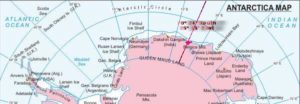 Pakistan is maintaining a summer research station (Jinnah Antarctic Station) and one weather observatory in the vicinity of Sør Rondane Mountains. Pakistan is also planning to build a full fledged permanent base at Antarctica which will enable the program to start operations in Antarctica throughout the year.
Pakistan is maintaining a summer research station (Jinnah Antarctic Station) and one weather observatory in the vicinity of Sør Rondane Mountains. Pakistan is also planning to build a full fledged permanent base at Antarctica which will enable the program to start operations in Antarctica throughout the year.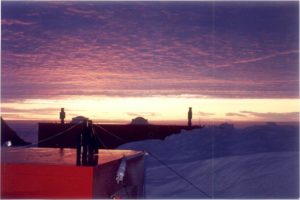 research station operated by the Pakistan Antarctic Program; facilities were quickly established in the region. The station houses an unmanned automatic Weather Station, from which data are transmitted to Pakistan via Argos Satellite System In 2001, the Badr-B was connected to the Weather Station after it was launched by SUPARCO. In 2006, Pakistan established the National Institute of Oceanography’s Polar Research Cell (PRC).
research station operated by the Pakistan Antarctic Program; facilities were quickly established in the region. The station houses an unmanned automatic Weather Station, from which data are transmitted to Pakistan via Argos Satellite System In 2001, the Badr-B was connected to the Weather Station after it was launched by SUPARCO. In 2006, Pakistan established the National Institute of Oceanography’s Polar Research Cell (PRC).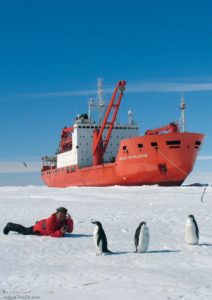 Oceanographic research ship Akademik Fedorov (or Fyodorov ) is one of the Russian icebreaker ships, a diesel-electric research vessel (RV) and the flagship of the Russian scientific polar research fleet. The ship was built for the USSR (Soviet Union) and started operations in October 1987.
Oceanographic research ship Akademik Fedorov (or Fyodorov ) is one of the Russian icebreaker ships, a diesel-electric research vessel (RV) and the flagship of the Russian scientific polar research fleet. The ship was built for the USSR (Soviet Union) and started operations in October 1987.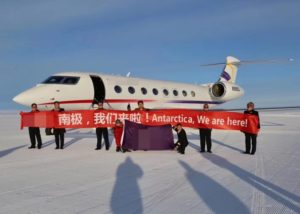 Media caption heading to Antarctica by plane is the exception, not the rule. According to Chinese media, the country’s first commercial flight to Antarctica brought 22 lucky tourists to the exotic destination this weekend.
Media caption heading to Antarctica by plane is the exception, not the rule. According to Chinese media, the country’s first commercial flight to Antarctica brought 22 lucky tourists to the exotic destination this weekend.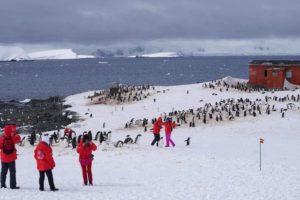 hours to the pole, where the flight landed on a 2.5-km (1.5-mile) runway carved into the ice.
hours to the pole, where the flight landed on a 2.5-km (1.5-mile) runway carved into the ice. To the Antarctic friends, followers & Chasers
To the Antarctic friends, followers & Chasers
